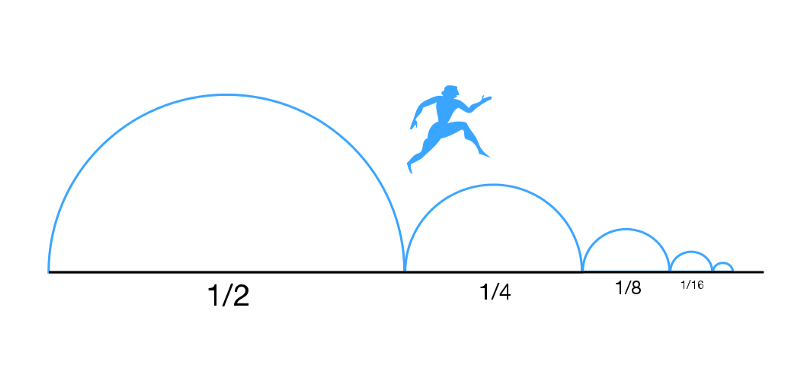A part of the reason for the number of bitcoin relates to a simple sequence that allows you to see how many bitcoin are left at a glance, at least as an approximate figure. I’ve been asked why the block subsidy started with 50 bitcoin each block, halving each block-reward period of four years.
There is an adequate number of bitcoin. More than we need for all of the uses that will ever be developed.
There is a particular form of a Zeno’s paradox known as the Dichotomy paradox.
That which is in locomotion must arrive at the half-way stage before it arrives at the goal.
— Aristotle, Physics VI:9
In Bitcoin, we don’t need to worry about an infinite number of tasks or halvings as the limits on integers allow the subsidy to disappear after around 2140. It’s an interesting sequence:

It looks different when we consider it another way. If we take 100 as an arbitrary amount because percentages are linked to 100, we can now transform the values in a way that has meaning.

You will notice the block reward in the first four years to have been at 50 bitcoin per block for the subsidy. It then drops to 25, then 12.5; and so on. And I have written them as 50/100, 25/100, et cetera for a reason.
In the first four years, miners competed to earn 50% of bitcoin that would ever exist. In the second halving, miners competed against each other to earn a further 25% of the total value of all bitcoin. At present, miners are competing to earn 12.5%. After the next halving, miners will compete to earn 6.25% of the total amount of bitcoin that will ever be available. That is, 1.6% of the total amount per annum.

In effect, the subsidy vanishes, but it is simple to see how much remains at any point in time.

When the block reward was 50 bitcoin as a subsidy, miners knew that 50% of the bitcoin would remain after the halving.
When the block subsidy halved to 25 bitcoin, miners knew at a glance that 50% of the bitcoin that would ever exist had been put out to market and that 25% would be remaining after the currrent block-subsidy period.
Simply put, the block subsidy equals the amount of bitcoin as a percentage that will remain as a subsidy at the end of the halving period.
So, as we move into the next halving in 2020 and the subsidy is reduced, the miners and others in the ecosystem can easily see that with a block subsidy of 6.25 bitcoin a block, only 6.25% of the bitcoin will remain available as a subsidy. That is, 93.75% of the subsidy will have already been collected and only 6.25 divided by 4 percent of the bitcoin subsidy will be available in each of the 4 following years. That is, 1.6% of the subsidy from the initial bitcoin will be available.
Which should make it very clear to the miners in the market that the bitcoin subsidy is not going to be sufficient. The halving will not create a flood of bitcoin value through a sudden increase in price.
Instead of a Zeno’s paradox, some promoting bitcoin in a Ponzi-like manner arguing that the price will double every halving are subject to the Persian chessboard or the rice and chessboard problem.

In falsely thinking that the price must keep doubling, they failed to understand that exponential processes quickly get out of hand. Exponentials cannot go on forever. Just like the rice on our chessboard, we eventually run out of the amount of anything needed, and in our case, there isn’t enough value and money on the earth to continue doubling the price of bitcoin based on the subsidy going away.
More importantly, it is looking at the wrong side of the equation. When the subsidy drops to 6.25 bitcoin per block, it means that nearly 90% of the total bitcoin supply will already be on the market. Miners are not the market alone. If the subsidy is the only way to earn and the transaction fee does not present the majority of how block rewards are supplied, miners will be irrelevant to the market.
The Ponzi cannot continue. If Bitcoin doesn’t move towards a model where the subsidy is no more than a small insignificant amount of the total reward earned by miners, then there will not be any value in Bitcoin.
Luckily, we have managed to demonstrate blocks the size of 2 GB on the Scaling Test Network (STN) and will be increasing the capacity further at a level that applications and other development teams can keep up with. In the coming years, we will be running blocks that are in the order of tens of terabytes in size. We will do so at a rate and cost that allow us to subsume all other transactions on the globe. We will do it more securely and inexpensively than PayPal, than Visa, than Mastercard, or than cash.
Bitcoin’s value did not ever lie in subverting government or banks, it lies in Bitcoin’s efficiency.

